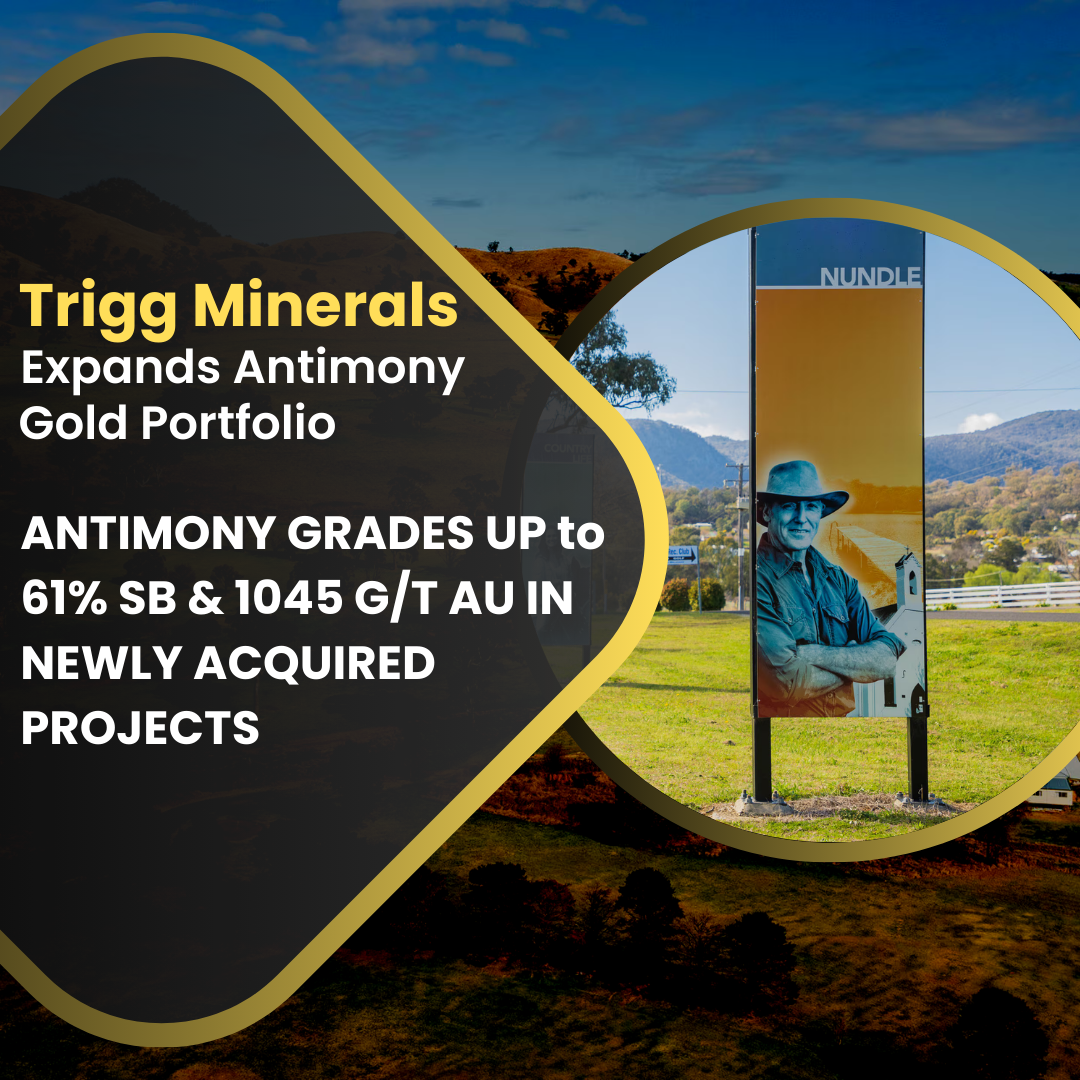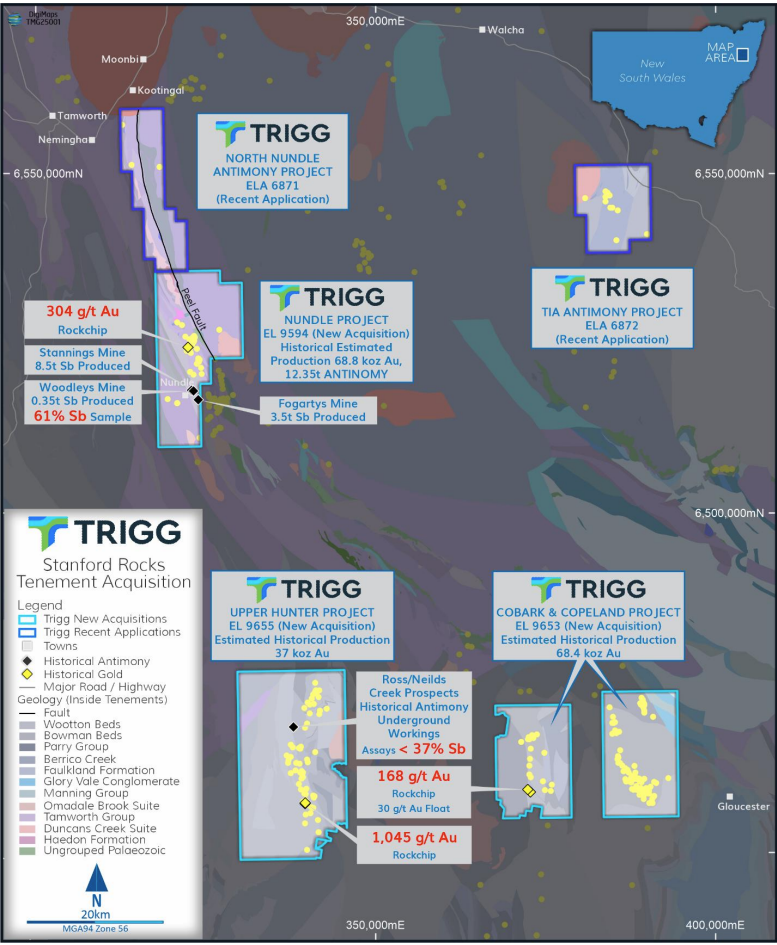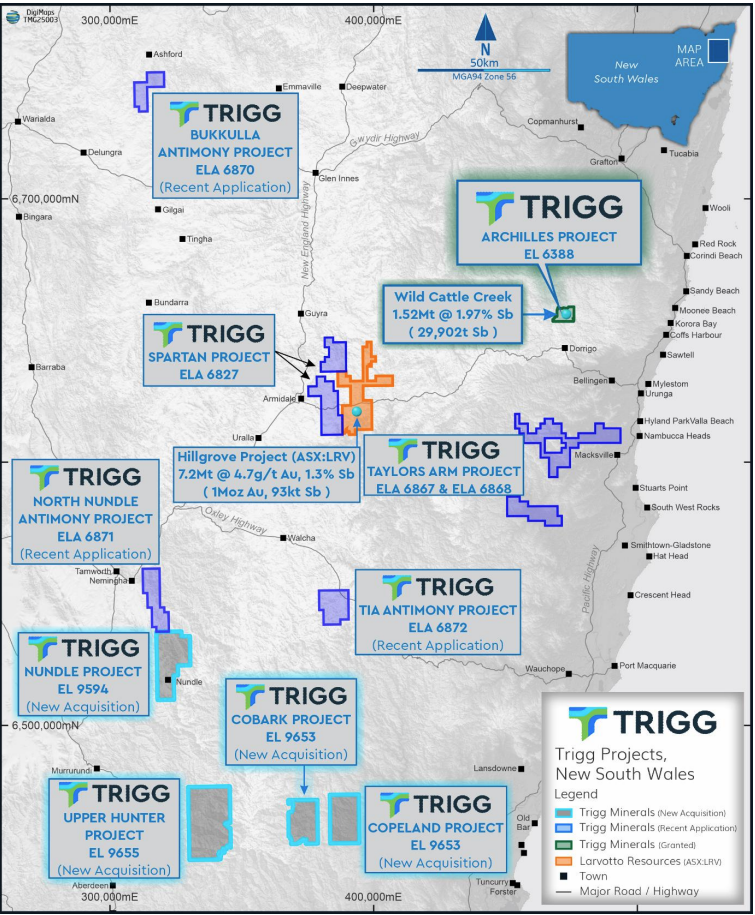by admin
Share
by admin
Share

ANTIMONY GRADES UP to 61% SB & 1045 G/T AU IN NEWLY ACQUIRED PROJECTS
Trigg has bolstered its landholding within the historic Nundle Goldfield, while securing additional Antimony-Gold high potential tenure.
The new acquisition strategically complements Trigg’s flagship WCC deposit, reinforcing the Company’s vision to establish itself as a leading antimony-focused entity and a future global supplier.
- Trigg Minerals has signed a binding purchase agreement to acquire 100% of the rights of the Nundle, Upper Hunter, Cobark/Copeland projects, conditional upon completion of due diligence. The projects cover an area of 1,039.7 km2 (256,915 acres)
- These projects will be developed as Trigg’s second flagship asset, complementing its primary, advanced-stage, high-grade JORC-compliant Wild Cattle Creek deposit. Trigg plans to deploy two dedicated exploration teams to simultaneously advance both projects. This dual-focused approach underscores Trigg’s commitment to becoming a major global player in the Antimony industry.
- The acquisition package encompasses five historically significant antimony deposits, featuring high-grade rock chip samples of 61% Sb and 9.7% Sb, alongside a recorded production of 12 tonnes of antimony (EL 9594, Nundle). Additionally, a 37% Sb sample collected from 12 meters down an adit (EL 9655, Upper Hunter) highlights the potential for deeper mineralisation.
- The tenements also boast over 60 historical gold mines and occurrences, each with a legacy of high-grade production. Notably, the Standard Reef, mined in 1904, reportedly yielded an estimated 15,000 ounces of gold at an impressive grade of 53.8 g/t Au. This rich historical production underscores the significant gold potential within the tenements, complementing their antimony prospects and further enhancing the overall value of Trigg’s exploration portfolio.
- The tenement package has an estimated historical production of 174,000 ounces of gold, achieved without the benefit of modern mining techniques and during periods of significantly lower gold prices. Initial assessments indicate that mineralisation remains open both along strike and at depth, with high-grade rock chip samples returning impressive grades ranging from 30 g/t Au to an exceptional 1,045 g/t Au. This combination of historical production and high-grade potential highlights the significant opportunity for further exploration and resource development within the package.
-
The inclusion of the Nundle Project into TMG’s North Nundle portfolio extends the Company’s prospective strike length along the underexplored yet highly prolific Peel Fault to approximately 40 kilometres. This strategic expansion significantly enhances the exploration potential of the region, providing TMG with a larger and more cohesive land package to target high-value mineralisation along this geologically significant structure.
Trigg Minerals Limited (ASX: TMG; OTCQB: TMGLF) (“Trigg” or the “Company”) is pleased to announce the acquisition of the Nundle, Upper Hunter and Cobark/Copeland Projects, a highly prospective tenement package covering a significant portion of the historic Nundle Goldfield and three additional historic goldfields within the New England Orogen (NEO) in northern New South Wales.

Figure 1; TMG’s latest tenement acquisition overlying local geology, historical Au and Sb occurrences
The acquisition includes four key projects:
Nundle (EL 9594)
The Nundle Goldfield has a rich history of gold production, with several historical antimony mines present within the region. It covers parts of the major Peel Fault and contains numerous old workings where typically small high-grade gold deposits occur in dolerites.
The expanded Nundle Project, encompassing both Nundle and North Nundle, provides Trigg access to a 40 km length of the Peel Fault, a deep-seated conduit for mineralising fluids, controlling the localisation of auriferous (gold-bearing) quartz veins and antimony deposits.
Several historical goldfields, including Nundle, Hanging Rock, and Bingara, are closely associated with this fault system.
Upper Hunter (EL 9655)
The Upper Hunter Goldfield in NSW is a historic gold-producing region known for its structurally controlled, quartz-vein-hosted gold deposits. Mineralisation occurs in fault breccia and shear zones within sedimentary rocks, with gold typically found alongside pyrite, arsenopyrite, minor chalcopyrite, and, locally, stibnite (antimony).
Cobark and Copeland (EL 9653)
The Cobark and Copeland Goldfields in NSW were prominent during the late 1800s gold rush. Mining focused on high-grade quartz veins hosted in faults and shear zones.
The Copeland area became a key mining hub, with underground workings targeting gold-rich sulphides such as pyrite, stibnite (antimony), arsenopyrite, and minor chalcopyrite.
The region remains highly prospective for modern exploration. The association of antimony mineralisation with gold enhances the project’s critical mineral potential, aligning with Trigg Minerals’ strategy to explore and develop high-value, multicommodity assets in Tier-1 mining jurisdictions.
STRATEGIC RATIONALE
The Projects are in an underexplored yet highly prospective region, with historical workings and strong geological indicators suggesting significant upside potential. The presence of both gold and antimony presents an exciting opportunity for Trigg to unlock new resources and expand its footprint in the strategic metals sector.
Tim Morrison, Executive Chairman of Trigg Minerals, commented:
“The acquisition of the Nundle and other Projects marks an exciting expansion for Trigg Minerals into historically productive goldfields with strong critical mineral potential. The presence of both gold and antimony in this underexplored region aligns perfectly with our focus on high-value, strategically significant minerals. We look forward to applying modern exploration techniques to uncover new opportunities within this proven mineral province.”
GEOLOGY AND MINERALISATION
The Nundle-Bingara belt hosts the most significant clusters of deposits, occurring adjacent to the Peel Fault or its subsidiary structures. These major dislocations appear to have controlled regional-scale fluid flow, while local structures determined the final emplacement of mineralisation.
Similarly, in the Copeland-Barrington goldfield, which includes the Upper Hunter, Copeland and Cobark Projects, gold-bearing veins are structurally controlled by faulting related to the Peel Fault system, with most mines clustered near a fold hinge and within Riedel shears. Across both regions, deposits typically occur within faults, shears, or joints, forming simple or multi-phase vein fillings. The veins consist primarily of quartz, with varying amounts of gold, sulphides (mainly stibnite, pyrite, and arsenopyrite), or scheelite, while ankerite or calcite is commonly present as late-stage infill.
The gold-antimony veins strongly prefer metasediments, volcanics, and serpentinite adjacent to major structural dislocations, reinforcing the importance of fault-controlled fluid flow in ore deposition. The surface distribution of deposits suggests a regional east-west zoning, with a thin, poorly defined scheelite belt, a central gold belt, and a stibnite belt, all broadly concordant with host rock bedding.
Three historical antimony mines—Stanning’s, Woodley’s, and Fogarty’s—are located within 2 km of each other in the Tamworth Group sediments in the Nundle area. These deposits are hosted in cherty argillites, occurring higher in the Tamworth Group stratigraphy than the goldquartz vein-bearing units.
A fourth stibnite deposit, documented by Odernheimer (1855a, b), was reportedly located near Silver Gully, north of this deposit group. Antimony occurs as stibnite in short, steeply pitching ore shoots within breccia zones, both with and without quartz. Minor gold (up to 10 g/t in stibnite) and occasional scheelite mineralisation are also present.
Traces of scheelite (an important tungsten ore) are present in several gold- and stibnitebearing reefs, though significant concentrations have only been identified in and around Zwer’s Scheelite Mine (164). This deposit consists of a quartz-scheelite vein hosted in dolerite and is located well away from any known gold deposits. Minor scheelite occurrences have also been recorded at the Rip and Tear Scheelite Prospect (201) and Fogarty’s Antimony Mine (179).
AGREEMENT TERMS
Under the terms of the Agreement, Trigg Minerals Limited (ASX: TMG) will acquire 100% ownership of the Nundle Goldfield (EL 9594), Upper Hunter (EL 9655), and Cobark and Copelands Goldfields (EL 9653) from Stanford Rocks Pty Ltd.
The material terms of the acquisition are as follows:
Vendor: Stanford Rocks Pty Ltd
Asset: Exploration Licenses EL 9594, EL 9655, and EL 9653
Consideration:
• AUD $250,000 payable in cash prior to completion.
• AUD $250,000 worth of fully paid ordinary shares in TMG (“Consideration Shares”), to be issued at a price based on the 10-day volume-weighted average price (VWAP) of TMG shares immediately prior to the completion date. • A 2% net smelter return (NSR) royalty on all minerals extracted from the tenement area, governed by a Royalty Deed to be executed at completion.
Escrow Terms:
The Consideration Shares will be subject to a three-month voluntary escrow period from the date of issue, underscoring TMG’s commitment to the long-term potential of this acquisition.

TMG Updated Tenement Location Map
